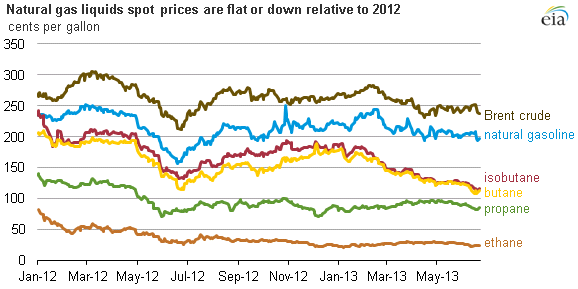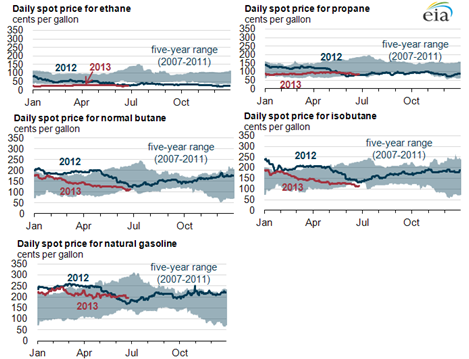
Natural gas liquids prices trend down since the start of 2012

Note: Natural gasoline is the product name used by the spot and futures markets to describe pentanes and hexanes. These are the primary components of pentanes plus, the term used by EIA in its surveys and reports.
Republished: July 29, 2013, 4:15 p.m.: Text was modified to update content.
Daily spot prices for natural gas liquids (NGL)—ethane, propane, normal butane, isobutane, and natural gasoline—have moderated because of a combination of ample supply, flat or moderating demand, export constraints, and domestic infrastructure constraints.

Ethane spot prices have been below the 2007-to-2012 range for every trading day in 2013 so far. For the first six months of 2013, ethane prices averaged 27 cents per gallon, over 45% below the price for the first six months of 2012. Ethane prices have been low compared with natural gas prices, prompting gas processors to leave it mixed in the natural gas stream, a phenomenon referred to as ethane rejection. Accordingly, net ethane production was down 9% for the first four months in 2013 compared to the same period in 2012, which may be applying some amount of price support.
Ethane demand comes almost exclusively from petrochemical plants, which have significant capital costs and take several years to build. Pipelines or liquefaction facilities to export ethane also face time and cost constraints, but there are projects underway to send ethane to the Gulf Coast to be processed, to export it to Canada, and to liquefy it and export it to Europe. The United States very recently began exporting ethane from the Marcellus shale play to Canada (week of July 21).
Spot propane traded at an average of 89 cents per gallon in the first half of 2013, compared to $1.12 per gallon in the first half of 2012. Since July 2012, propane prices have remained relatively flat. The average propane price for the second half of 2012 was also 89 cents per gallon, the same as for the first half of 2013. Propane is a petrochemical feedstock, similar to ethane, but also serves as an important home-heating fuel. Net propane production was up 8% through April 2013 compared to the same time period in 2012. The price effects of increased production have been mitigated by increased exports. Propane/propylene exports, primarily going to Latin America, are up 42% through April this year versus the same period last year.
Normal butane and isobutane spot prices have recently moved together, falling by 22% and 23%, respectively, in the first half of 2013 compared with the first half of 2012. By the end of June 2013, both products were near or below the 2007-to-2012 range for this period. Since both normal butane and isobutane are important blendstock for motor gasoline, lower-than-usual gasoline demand may be reducing demand for these products and applying downward pressure on their prices. Increased supply may also be pushing prices down. Net production levels of normal butane and isobutane were up 9% and 12%, respectively, for the first four months of 2013 compared to the first four months of 2012.
Natural gasoline prices fell by about 8% in the first half of 2013 compared to the first half of 2012, averaging $2.14 per gallon, down from $2.34 per gallon. Natural gasoline prices have remained highly correlated to movements in crude oil prices in recent months, unlike the prices of other NGL products. Production of natural gasoline (which is referred to as pentanes plus by producers and in EIA reports) is up about 8% so far this year compared to the same period last year. Natural gasoline can be used as a diluent (a diluting agent) for heavy crude oil, or as a blendstock for motor gasoline (regular 10% ethanol blend as well as high-percentage ethanol blends known as E85).